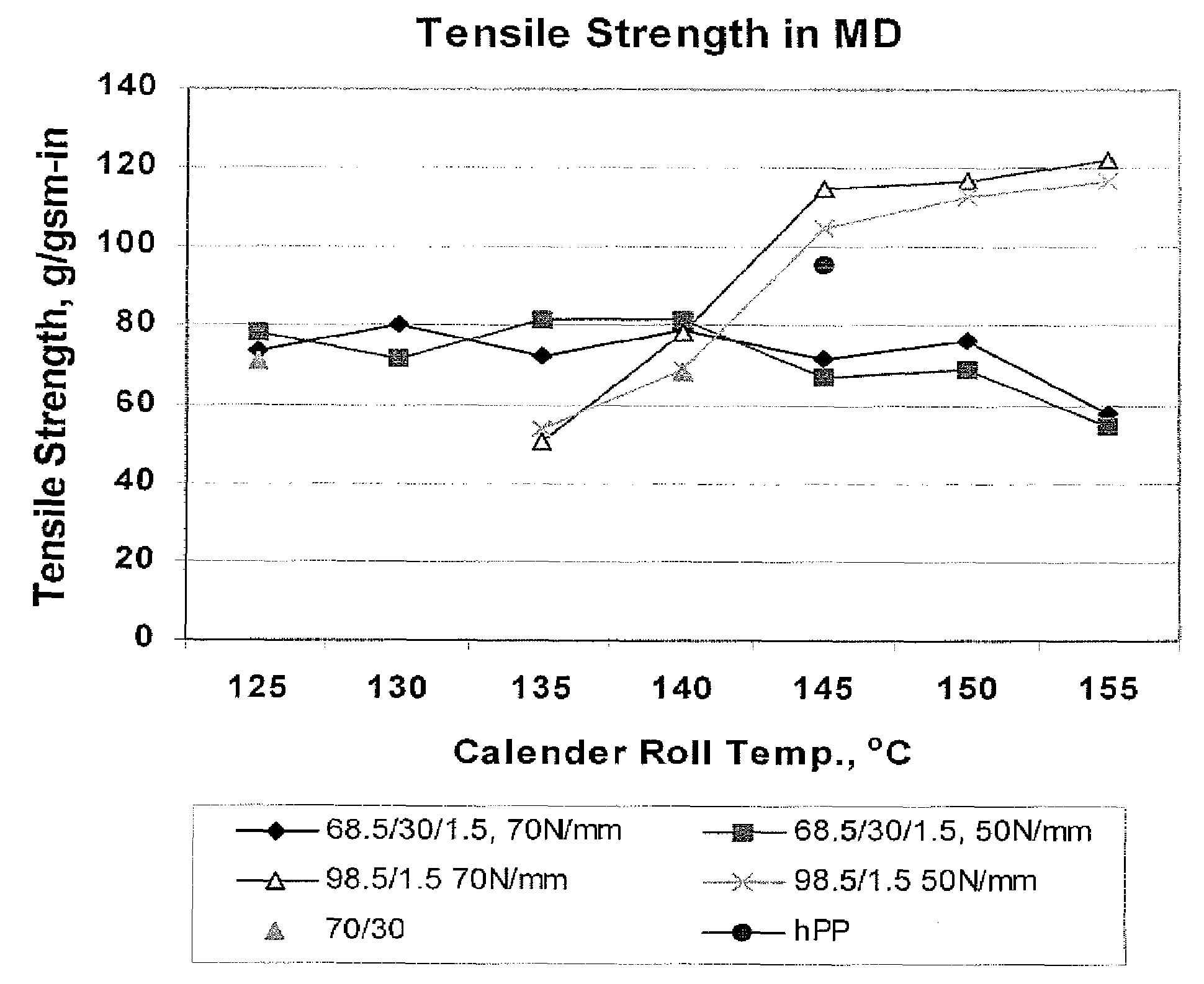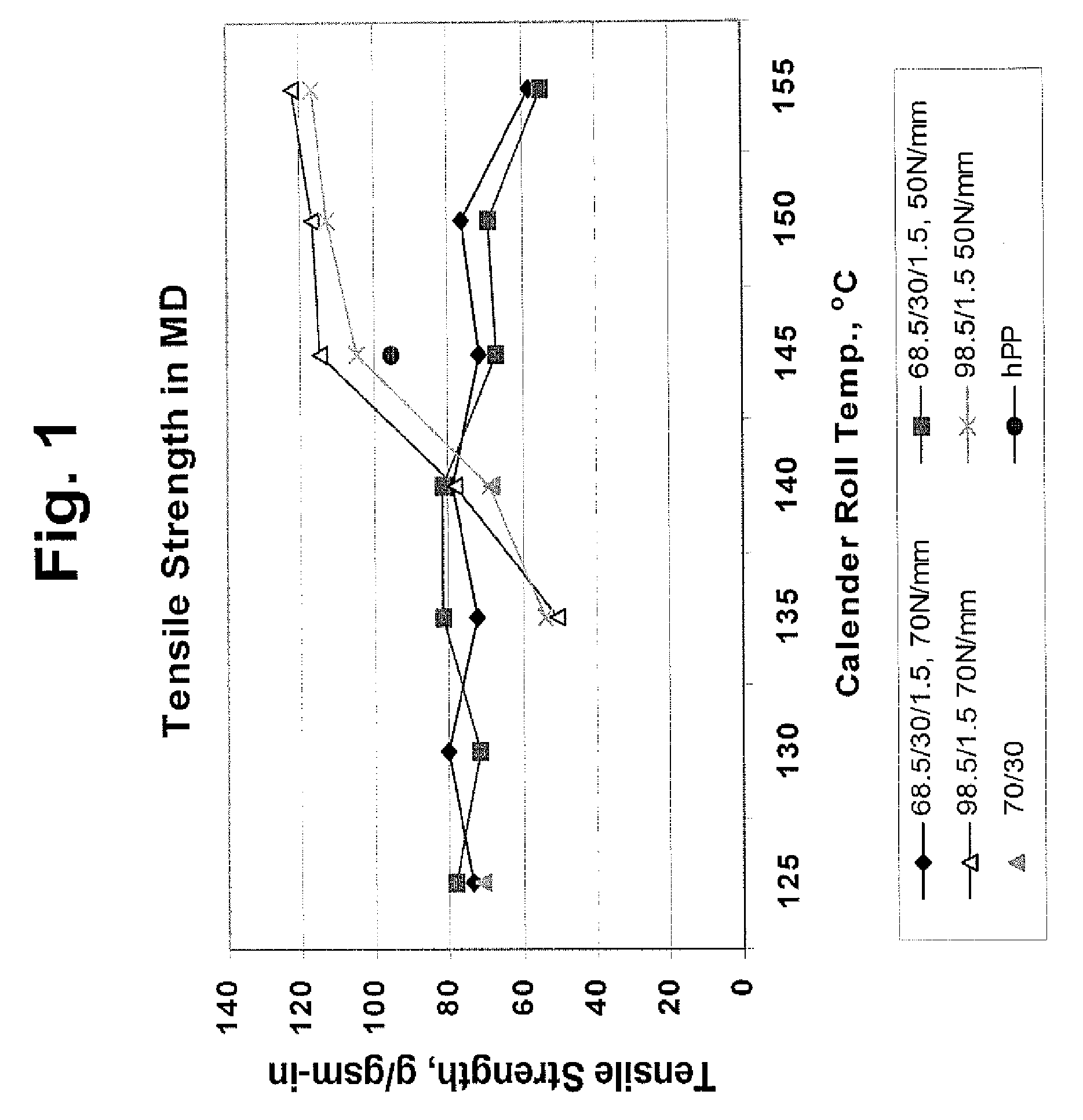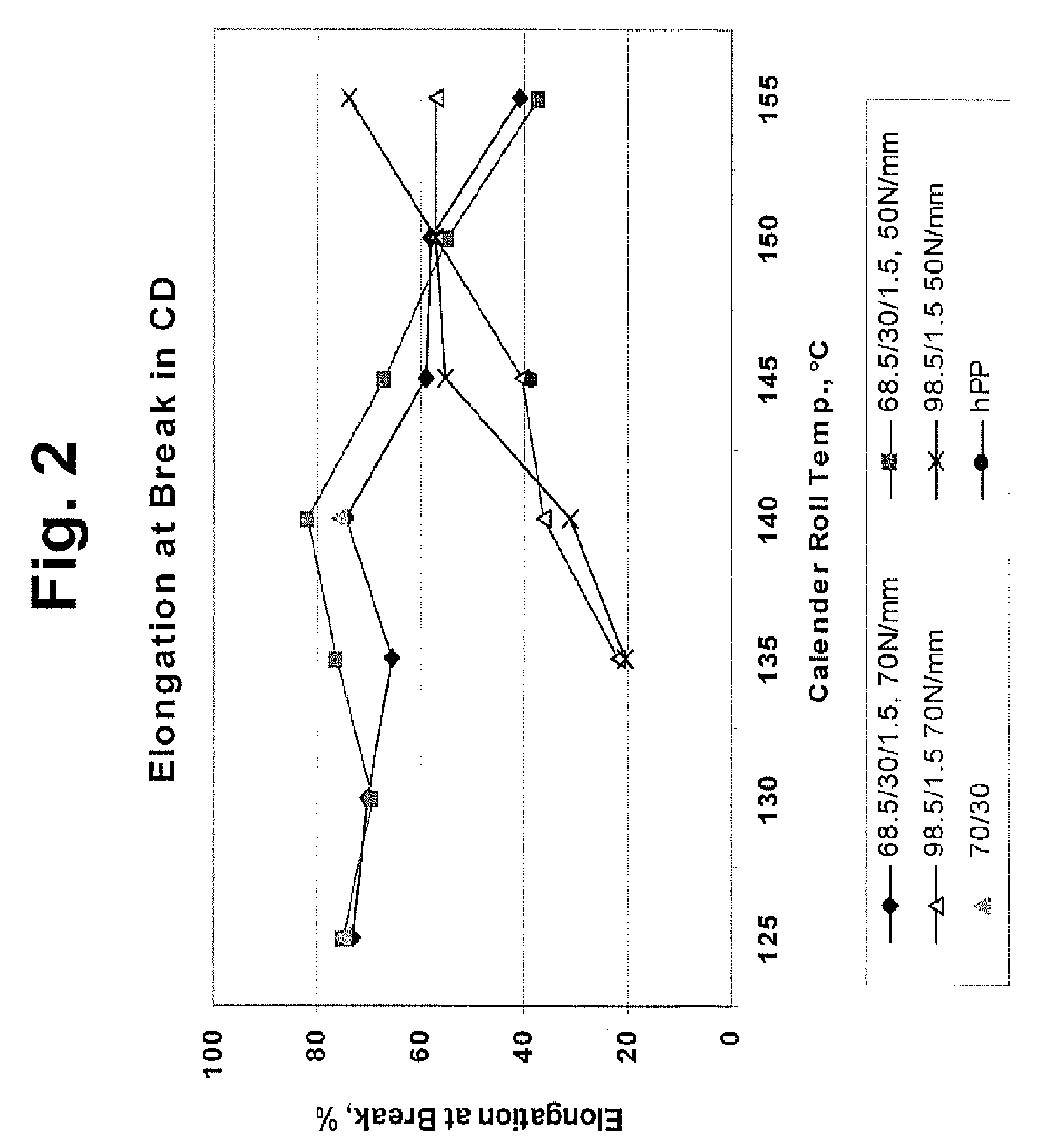Soft and extensible polypropylene based spunbond nonwovens
Inactive Publication Date: 2009-04-30
DOW GLOBAL TECH LLC
View PDF44 Cites 53 Cited by
- Summary
- Abstract
- Description
- Claims
- Application Information
AI Technical Summary
Benefits of technology
[0088]The fibers of the present invention are well suited for use in a spunbond nonwoven fabric. The nonwoven material of the present invention will preferably have a basis weight (weight per unit area) from 10 grams per square meter (gsm) to 300 gsm. In certain embodiments it is preferred that the nonwoven material have a basis weight of from 10 to 30 gsm. The basis weight can also be from 15 gsm to 60 gsm, and in one embodiment it can be about 20 gsm. Suitable base nonwoven webs can have an average filament denier of 0.10 to 10. Very low deniers can be achieved by the use of splittable fiber technology, for example. In general, reducing the filament denier tends to produce softer webs, and low denier microfibers from 0.10 to 2.0 denier can be utilized for even greater softness.
[0094]The web of the present invention is characterized by high abrasion resistance and high softness, which properties are quantified by the web's tendency to fuzz and bending or flexural rigidity, respectively. Fuzz levels (or “fuzz / abrasion”) and flexural rigidity were determined according to the methods set out in the Test Methods section of WO02 / 31245, herein incorporated by reference in its entirety.
[0106]In another aspect of the invention, a method of improving the softness of a spunbond nonwoven fabric is provided. The method comprises A) selecting a polymer comprising i) from 50 to 90 percent (by weight of the fiber) of a first polymer which is an isotactic polypropylene homopolymer or random copolymer having a melt flow rate in the range of from 10 to 70 grams / 10 minutes, and ii) from 10 to 50 percent (by weight of the fiber) of a second polymer which is a reactor grade propylene based elastomer or plastomer having a heat of fusion less than about 70 joules / gm, said propylene based elastomer or plastomer having a melt flow rate of from 2 to 1000 grams / 10 minutes, B) adding a sufficient amount of slip agent to impart desired softness attributes to the fiber; and C) forming a spun bond melt blown fabric from the polymer in A with the slip agent in B.
[0107]Another aspect of the present invention is the use of slip agent to improve the softness of propylene based spunbond nonwoven fabrics. The preferred slip agent for this use is erucamide, and it preferably comprises from 100 ppm to 2500 ppm, preferably from at least 150 ppm to less than 2000 ppm, more preferably from 200 to 1500 ppm, and still more preferably from 250 ppm to less than 1000 ppm by weight of the nonwoven.EXAMPLESTesting Methods
Problems solved by technology
Fuzzing can result in fibers remaining on the skin or clothing of the wearer or others, as well as a loss of integrity in the nonwoven, both highly undesirable conditions for users.
However, it is believed that such mechanical methods would negatively effect the fuzz levels (or decrease the abrasion resistance) observed in such nonwoven webs.
However, the multicomponent fibers disclosed comprise a relatively expensive elastomeric thermoplastic material (that is KRATON™) in one side or the sheath of multicomponent polymeric strands.
The specified bond shapes reportedly provide sufficient numbers of immobilized fibers to strengthen the fabric, yet not so much as to increase stiffness unacceptably.
However, with all bond pattern solutions it is believed that the essential tradeoff between bond area and softness remains.
Of the various polymers known to be extrudable into fiber, highly branched LDPE has not been successfully melt spun into fine denier fiber.
While the use of blends of heterogeneously branched polymers produces improved fabric, the polymers are more difficult to spin without fiber breaks.
However, while Stahl et al. provides some teaching as to the manipulation of bond temperature by using blends of different fibers, Stahl et al. does not provide guidance as to means for improving fabric strength of fabric made from fibers having the same melting point.
U.S. Pat. No. 5,804,286 teaches that the bonding of LLDPE filaments into a spunbond web with acceptable abrasion resistance is difficult since the temperature at which acceptable tie down is observed is nearly the same as the temperature at which the filaments melt and stick to the calendar.
The inventors of the present invention have found that such levels lead to die build up which hurts the spinnability of such materials in a spunbond process, as well as resulting in fabrics having an oily feel which is considered detrimental in many parts of the world.
Additionally, there is a continuing unaddressed need for a low fuzzing, soft nonwoven suitable for use as a component in a disposable absorbent article.
Additionally, there is a continuing unaddressed need for a soft, extensible nonwoven web having relatively high abrasion resistance.
Further, there is a continuing unaddressed need for a method of processing a nonwoven such that abrasion resistance is achieved with little or no decrease in softness.
Method used
the structure of the environmentally friendly knitted fabric provided by the present invention; figure 2 Flow chart of the yarn wrapping machine for environmentally friendly knitted fabrics and storage devices; image 3 Is the parameter map of the yarn covering machine
View moreImage
Smart Image Click on the blue labels to locate them in the text.
Smart ImageViewing Examples
Examples
Experimental program
Comparison scheme
Effect test
example 1
[0128 was: 68.5 (percent by weight) Resin A / 30 percent Resin B / 1.5 percent Ampacet 10090 (LDPE as the polymer carrier of the masterbatch, equivalent to 750 ppm erucamide).
[0129]Three comparative resins or resin blends are also prepared:
example 2 (comparative)
[0130 98.5 percent Resin A / 1.5 percent Ampacet 10090
example 3 (comparative)
[0131 70 percent Resin A / 30 percent Resin B
the structure of the environmentally friendly knitted fabric provided by the present invention; figure 2 Flow chart of the yarn wrapping machine for environmentally friendly knitted fabrics and storage devices; image 3 Is the parameter map of the yarn covering machine
Login to View More PUM
| Property | Measurement | Unit |
|---|---|---|
| Fraction | aaaaa | aaaaa |
| Fraction | aaaaa | aaaaa |
| Fraction | aaaaa | aaaaa |
Login to View More
Abstract
The present invention relates to nonwoven webs or fabrics. In particular, the present invention relates to nonwoven webs having superior abrasion resistance and excellent softness characteristics. The nonwoven materials comprise fibers made from of a polymer blend of isotactic polypropylene and reactor grade propylene based elastomers or plastomers together with from about 100 to about 2500 ppm (by weight of the fiber) of a slip agent. The isotactic polypropylene can be homopolymer polypropylene, and / or random copolymers of propylene and one or more alpha-olefins. The reactor grade propylene based elastomers or plastomers have a molecular weight distribution of less than about 3.5, and a heat of fusion less than about 90 joules / gm. In particular, the reactor grade propylene based elastomers or plastomers contains from about 3 to about 15 percent by weight of units derived from an ethylene and a melt flow rate of from about 2 to about 200 grams / 10 minutes. Erucamide is the preferred slip additive.
Description
CROSS REFERENCE STATEMENT[0001]This application claims the benefit of U.S. Provisional Application No. 60 / 808,349, filed May 25, 2006.FIELD OF THE INVENTION[0002]The present invention relates to nonwoven webs or fabrics. In particular, the present invention relates to nonwoven webs having good drapeability, superior abrasion resistance and excellent softness characteristics. The nonwoven materials comprise fibers made from of a polymer blend of isotactic polypropylene, reactor grade propylene based elastomers or plastomers, and a slip additive.BACKGROUND AND SUMMARY OF THE INVENTION[0003]Nonwoven webs or fabrics are desirable for use in a variety of products such as bandaging materials, garments, disposable diapers, and other personal hygiene products, including pre-moistened wipes. Nonwoven webs having high levels of strength, softness, and abrasion resistance are desirable for disposable absorbent garments, such as diapers, incontinence briefs, training pants, feminine hygiene pro...
Claims
the structure of the environmentally friendly knitted fabric provided by the present invention; figure 2 Flow chart of the yarn wrapping machine for environmentally friendly knitted fabrics and storage devices; image 3 Is the parameter map of the yarn covering machine
Login to View More Application Information
Patent Timeline
 Login to View More
Login to View More IPC IPC(8): D04H5/00B29C47/00D04H3/153
CPCD01F1/10D04H3/16D01F6/46Y10T442/608B32B27/02D04H1/4291D04H3/007
Inventor PENG, HONGCLAASEN, GERT J.VAN DUN, JOZEF J.ALLGEUER, THOMAS T.
Owner DOW GLOBAL TECH LLC
Features
- R&D
- Intellectual Property
- Life Sciences
- Materials
- Tech Scout
Why Patsnap Eureka
- Unparalleled Data Quality
- Higher Quality Content
- 60% Fewer Hallucinations
Social media
Patsnap Eureka Blog
Learn More Browse by: Latest US Patents, China's latest patents, Technical Efficacy Thesaurus, Application Domain, Technology Topic, Popular Technical Reports.
© 2025 PatSnap. All rights reserved.Legal|Privacy policy|Modern Slavery Act Transparency Statement|Sitemap|About US| Contact US: help@patsnap.com



